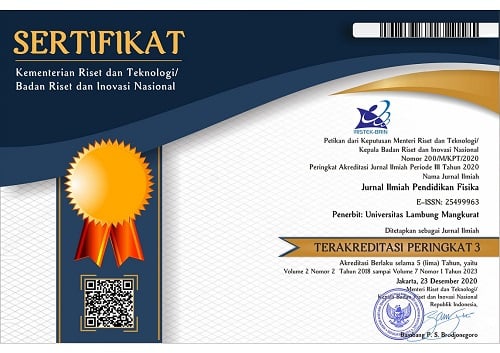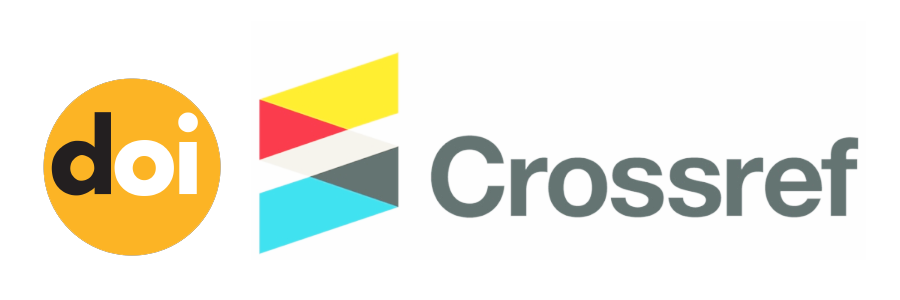The Development of Adaptive E-Scaffolding to Support the Academic Diversity of High School Students on Mechanical Waves Material
Abstract
Waves are an abstract concept frequently challenging for students to grasp, as it is believed that only talented students can master it. Moreover, upon entering the classroom, each student possesses a unique understanding. Differentiated learning is suggested as a solution to manage the diversity of students in the classroom. This study aims to develop adaptive e-scaffolding for the Moodle LMS. This study design was the research and development using Analyze, Design, Develop, Implement, and Evaluate (ADDIE) model. Variable levels of scaffolding are incorporated into adaptive e-scaffolding by student abilities. The validation conducted by three experts in physics education and educational technology yielded a score of 3.78 and deemed adaptive e-scaffolding valid. The implementation outcomes show that the adaptive e-scaffolding achieves an average readability percentage of 79.2%, and the highest score was obtained in the feedback category. In summary, implementing adaptive learning technologies, such as e-scaffolding, can enhance students' engagement with learning materials and assist teachers in addressing classroom diversity. Teachers, e-learning developers, and other professionals in the field of education must give due consideration to how technology enables adaptive learning strategies.
Keywords
Full Text:
PDFReferences
Aitdaoud, M., Namir, A., & Talbi, M. (2023). A new pre-processing approach based on clustering users traces according to their learning styles in moodle LMS. International Journal of Emerging Technologies in Learning (iJET), 18(07), Article 07. https://doi.org/10.3991/ijet.v18i07.37635
Al-Hunaiyyan, A., Al-Sharhan, S., & AlHajri, R. (2020). Prospects and challenges of learning management systems in higher education. International Journal of Advanced Computer Science and Applications (IJACSA), 11(12), Article 12. https://doi.org/10.14569/IJACSA.2020.0111209
Alshareef, K. K., Imbeau, M. B., & Albiladi, W. S. (2022). Exploring the use of technology to differentiate instruction among teachers of gifted and talented students in Saudi Arabia. Gifted and Talented International, 37(1), 64–82. https://doi.org/10.1080/15332276.2022.2041507
Am, M. A., Hadi, S., & Istiyono, E. (2023). Trend research mapping of differentiated instruction: A bibliometric analysis. Journal of Pedagogical Research, 7(3), 194–210. https://doi.org/10.33902/JPR.202320544
Astiti, K. A., Lantik, V., Sukarjita, I. W., & Fakhrudin. (2023). Pelatihan penyusunan RPP Pembelajaran berdiferensiasi untuk mewujudkan merdeka belajar di SMA N 2 Kupang Timur. Jurnal Pengabdian Kepada Masyarakat Nusantara, 4(2), Article 2. https://doi.org/10.55338/jpkmn.v4i2.1070
Belland, B. R., Walker, A. E., Kim, N. J., & Lefler, M. (2017). Synthesizing results from empirical research on computer-based scaffolding in STEM education: a meta-analysis. Review of Educational Research, 87(2), 309–344. https://doi.org/10.3102/0034654316670999
Branch, R. M. (2009). Prologue. In R. M. Branch (Ed.), Instructional design: The ADDIE approach (pp. 1–20). Springer US. https://doi.org/10.1007/978-0-387-09506-6_1
Estaiteyeh, M., & DeCoito, I. (2023). Differentiated instruction in digital video games: STEM teacher candidates using technology to meet learners’ needs. Interactive Learning Environments, 0(0), 1–15. https://doi.org/10.1080/10494820.2023.2190360
Gamage, S. H. P. W., Ayres, J. R., & Behrend, M. B. (2022). A systematic review on trends in using Moodle for teaching and learning. International Journal of STEM Education, 9(1), 9. https://doi.org/10.1186/s40594-021-00323-x
Gheyssens, E., Coubergs, C., Griful-Freixenet, J., Engels, N., & Struyven, K. (2022). Differentiated instruction: The diversity of teachers’ philosophy and praxis to adapt teaching to students’ interests, readiness and learning profiles. International Journal of Inclusive Education, 26(14), 1383–1400.
https://doi.org/10.1080/13603116.2020.1812739
Goodhew, L. M., Robertson, A. D., Heron, P. R. L., & Scherr, R. E. (2019). Student conceptual resources for understanding mechanical wave propagation. Physical Review Physics Education Research, 15(2), 020127. https://doi.org/10.1103/PhysRevPhysEducRes.15.020127
Ikhsan, R. B., Prabowo, H., Yuniarty, Y., Simamora, B., Ruan, X., & Kumar, V. (2023). Predicting Students’ Use of Mobile e-Learning Management Systems in Indonesia. The Journal of Educators Online, 20(1). https://doi.org/10.9743/JEO.2023.20.1.20
Johler, M., & Krumsvik, R. J. (2022). Increasing inclusion through differentiated instruction in a technology-rich primary school classroom in Norway. Education 3-13, 0(0), 1–15. https://doi.org/10.1080/03004279.2022.2143721
Kanyesigye, S. T., Uwamahoro, J., & Kemeza, I. (2022). Difficulties in understanding mechanical waves: Remediated by problem-based instruction. Physical Review Physics Education Research, 18(1), 010140. https://doi.org/10.1103/PhysRevPhysEducRes.18.010140
Kim, N. J., Belland, B. R., Lefler, M., Andreasen, L., Walker, A., & Axelrod, D. (2020). Computer-based scaffolding targeting individual versus groups in problem-centered instruction for STEM education: meta-analysis. Educational Psychology Review, 32(2), 415–461. https://doi.org/10.1007/s10648-019-09502-3
Kristiani, H., Susanti, E. I., Purnamasari, N., Purba, M., Saad, M. Y., & Anggaeni. (2021). Model pengembangan pembelajaran berdiferensiasi (differentiated instruction) pada kurikulum fleksibel sebagai wujud merdeka belajar di SMPN 20 Kota Tangerang Selatan. Pusat Kurikulum dan Pembelajaran Badan Standar, Kurikulum, dan Asesmen Pendidikan Kementerian Pendidikan, Kebudayaan, Riset, dan Teknologi.
Kuang, X., Eysink, T. H. S., & Jong, T. (2020). Effects of providing partial hypotheses as a support for simulation‐based inquiry learning. Journal of Computer Assisted Learning, 36(4), 487–501. https://doi.org/10.1111/jcal.12415
Lazonder, A. W., & Harmsen, R. (2016). Meta-analysis of inquiry-based learning: effects of guidance. Review of Educational Research, 86(3), 681–718. https://doi.org/10.3102/0034654315627366
Mastuti, A. G., Abdillah, A., & Rumodar, M. (2022). Peningkatan kualitas pembelajaran guru melalui workshop dan pendampingan pembelajaran berdiferensiasi. JMM (Jurnal Masyarakat Mandiri), 6(5). https://doi.org/10.31764/jmm.v6i5.9682
Nancekivell, S. E., Sun, X., Gelman, S. A., & Shah, P. (2021). A slippery myth: how learning style beliefs shape reasoning about multimodal instruction and related scientific evidence. Cognitive Science, 45(10), e13047. https://doi.org/10.1111/cogs.13047
Nurlaili, N., Suhirman, S., & Lestari, M. (2023). Pembelajaran berdiferensiasi dengan memanfaatkan multimedia pada pembelajaran pendidikan agama islam(pai). Belajea: Jurnal Pendidikan Islam, 8(1), Article 1. https://doi.org/10.29240/belajea.v8i1.6808
Ožvoldová, M., Schauer, F., Ožvoldová, M., & Schauer, F. (2012). Remote experiments in freshman engineering education by integrated e-learning. In Internet Accessible Remote Laboratories: Scalable E-Learning Tools for Engineering and Science Disciplines (remote-experiments-freshman-engineering-education). IGI Global. https://www.igi-global.com/gateway/chapter/www.igi-global.com/gateway/chapter/61452
Peters, M. T., Hebbecker, K., & Souvignier, E. (2021). Effects of providing teachers with tools for implementing assessment-based differentiated reading instruction in second grade. Assessment for Effective Intervention, 15345084211014926.
https://doi.org/10.1177/15345084211014926
Pozas, M., Letzel, V., Lindner, K.-T., & Schwab, S. (2021). DI (Differentiated Instruction) does matter! the effects of di on secondary school students’ well-being, social inclusion and academic self-concept. Frontiers in Education, 6. https://www.frontiersin.org/article/10.3389/feduc.2021.729027
Purwanto, A. J., & Gita, R. S. D. (2023). Pengembangan media pembelajaran matematika berdiferensiasi berbasis android. Prismatika: Jurnal Pendidikan Dan Riset Matematika, 5(2), Article 2. https://doi.org/10.33503/prismatika.v5i2.2696
Rangkuti, M. A., & Karam, R. (2022). Conceptual challenges with the graphical representation of the propagation of a pulse in a string. Physical Review Physics Education Research, 18(2), 020119. https://doi.org/10.1103/PhysRevPhysEducRes.18.020119
Safarati, N., & Zuhra, F. (2023). Literature review: pembelajaran berdiferensiasi di sekolah menengah. Jurnal Genta Mulia, 14(1), Article 1. https://ejournal.stkipbbm.ac.id/index.php/gm/article/view/17
Santoso, P. H., Istiyono, E., & Haryanto. (2022). Physics teachers’ perceptions about their judgments within differentiated learning environments: a case for the implementation of technology. Education Sciences, 12(9), Article 9. https://doi.org/10.3390/educsci12090582
Sun, Y., & Xiao, L. (2021). Research trends and hotspots of differentiated instruction over the past two decades (2000-2020): A bibliometric analysis. Educational Studies, 0(0), 1–17. https://doi.org/10.1080/03055698.2021.1937945
Suprayogi, M. N., Valcke, M., & Godwin, R. (2017). Teachers and their implementation of differentiated instruction in the classroom. Teaching and Teacher Education, 67, 291–301. https://doi.org/10.1016/j.tate.2017.06.020
Sutaga, I. W. (2022). Tingkatkan kompetensi guru melalui pembelajaran berdiferensiasi. Inovasi Jurnal Guru, 8(9), Article 9.
Usman, U., Lestari, I. D., Alfianisya, A., Octavia, A., Lathifa, I., Nisfiyah, L., Aries, N. A. P., & Oktatira, R. (2022). Pemahaman salah satu guru di man 2 tangerang mengenai sistem pembelajaran berdiferensiasi pada kurikulum merdeka. Jurnal Review Pendidikan Dan Pengajaran (JRPP), 5(1), Article 1. https://doi.org/10.31004/jrpp.v5i1.4432
Westbroek, H. B., van Rens, L., van den Berg, E., & Janssen, F. (2020). A practical approach to assessment for learning and differentiated instruction. International Journal of Science Education, 42(6), 955–976. https://doi.org/10.1080/09500693.2020.1744044
Wood, D., Bruner, J. S., & Ross, G. (1976). The role of tutoring in problem solving*. Journal of Child Psychology and Psychiatry, 17(2), 89–100. https://doi.org/10.1111/j.1469-7610.1976.tb00381.x
Xie, L., Liu, Q., Lu, H., Wang, Q., Han, J., Feng, X., & Bao, L. (2021).
Student knowledge integration in learning mechanical wave propagation. Physical Review Physics Education Research, 17(2), 020122. https://doi.org/10.1103/PhysRevPhysEducRes.17.020122
Y. Erinosho, S. (2013). How do students perceive the difficulty of physics in secondary school? an exploratory study in nigeria. International Journal for Cross-Disciplinary Subjects in Education, 3(Special 3), 1510–1515. https://doi.org/10.20533/ijcdse.2042.6364.2013.0212
Zacharia, Z. C., Manoli, C., Xenofontos, N., de Jong, T., Pedaste, M., van Riesen, S. A. N., Kamp, E. T., Mäeots, M., Siiman, L., & Tsourlidaki, E. (2015). Identifying potential types of guidance for supporting student inquiry when using virtual and remote labs in science: A literature review. Educational Technology Research and Development, 63(2), 257–302. https://doi.org/10.1007/s11423-015-9370-0
DOI: https://doi.org/10.20527/jipf.v8i1.9823
Refbacks
- There are currently no refbacks.
Indexed by: Jurnal Ilmiah Pendidikan Fisika is licensed under a creative commons attribution-share alike 4.0 international license
Statistics Counter |
















